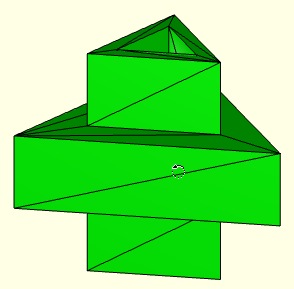FLfeatureEdgeSurface
by Tim C. Lueth, SG-Lib Toolbox: SolidGeometry 5.6 - FS/Feature Surfaces
Introduced first in SolidGeometry 2.1, Creation date: 2014-12-30, Last change: 2025-09-14
returns a surface facet list based on a given surface triangulation
Description
This function analyses the feature edges of a surface, reconnects them into contours, and uses delaunay triangulation on the same points to recalculate the surface. It uses
TRfeatureEdgeFacets
PLELofFeatureEdges2
FLofVLELn
for reconstruction.
See Also: FLfeatureEdgeSurface
, FLfeatureEdgeSurface2
, PLELofFeatureEdges
, PLELofFeatureEdges2
, TRfeatureEdgeFacets
, FEplot
Example Illustration

Syntax
FL=FLfeatureEdgeSurface(TR3,angle)
Input Parameter
TR3: | | Surface volume triangulation |
angle: | | filter angle for feature edges |
Output Parameter
FL: | | Facet List w.r.t TR3.Points |
Examples
Create a solid and recreate the surface
SG=SGsample(7);
VLFLplots(SG.VL, FLfeatureEdgeSurface(triangulation(SG.FL,SG.VL),0.01),'g');
Copyright 2014-2025 Tim C. Lueth. All rights reserved. The code is the property of Tim C. Lueth and may not be redistributed or modified without explicit written permission. This software may be used free of charge for academic research and teaching purposes only. Commercial use, redistribution, modification, or reverse engineering is strictly prohibited. Access to source code is restricted and granted only under specific agreements. For licensing inquiries or commercial use, please contact: Tim C. Lueth
Algorithm (Workflow)
This function, FLfeatureEdgeSurface, is designed to analyze and reconstruct the feature edges of a surface based on a given surface triangulation. It uses several helper functions to achieve this, including TRfeatureEdgeFacets, PLELofFeatureEdges2, and FLofVLELn.
Input Parameters
- TR3: This is the surface volume triangulation input, which contains the points and connectivity information of the surface.
- angle: This parameter is a filter angle used to determine which edges are considered feature edges based on their angular deviation.
Output
- FL: The output is a facet list that corresponds to the points in
TR3.Points.
Algorithm Steps
- Extract the vertex list
VL from the triangulation TR3.
- Call
PLELofFeatureEdges2 with TR3 and angle to obtain the edge list ELFL and segment information list SIL.
- Determine the number of unique segments
n from SIL.
- Initialize an empty facet list
FL.
- For each segment
i from 1 to n:
- Find all entries in
SIL that belong to the current segment i.
- Initialize an empty edge list
EL for the current segment.
- For each entry
j in the current segment:
- Append the corresponding edges from
ELFL to EL.
- Call
FLofVLELn with VL, EL, and the segment information from SIL to obtain the facet list for the current segment.
- Append the resulting facet list to
FL.
- If no output is requested, plot the vertex list and facet list using
VLFLplots with the color 'g' (green).
Algorithm explaination created using ChatGPT on 2025-08-19 01:32. (Please note: No guarantee for the correctness of this explanation)
Last html export of this page out of FM database by TL: 2025-09-21